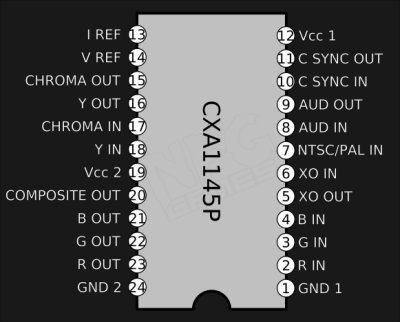This is an old revision of the document!
Sega Master System A/V Info
The Sega Master System II, a redesigned (and partially stripped-down) version of the SMS, doesn't have RGB or even composite output. RF only, also known as OH GOD MEIN EYES. There is, however, a TV encoder chip in there which can be soldered to for just about anything you'd like. I've personally seen two different ones, but that's not much of a problem as data sheets for either are relatively readily available. Nevertheless, for your convenience here's what you want to know - the chips are identical in function, but it took me a while to find out which chip even was the TV encoder on Variant B.
As for connecting the whole thing, there's plenty of space at the back right of the case. I could quite comfortably fit a SCART jack in there. Knock yourself out.
Variant A: Sony CXA1145P
Variant A is actually the same chip as in the SMS1. CXA1145, this is the internet. Internet, the Sony CXA1145P.
| Pin | Signal | Pin | Signal |
|---|---|---|---|
| 13 | Iref | 12 | Vcc1 (5V) |
| 14 | Vref | 11 | Sync Out |
| 15 | Chroma Out | 10 | Sync In |
| 16 | Y Out | 9 | Audio Out |
| 17 | Chroma In | 8 | Audio In |
| 18 | Y In | 7 | NTSC/PAL In |
| 19 | Vcc2 (5V) | 6 | XO In |
| 20 | Composite Out | 5 | XO Out |
| 21 | B Out | 4 | B In |
| 22 | G Out | 3 | G In |
| 23 | R Out | 2 | R In |
| 24 | GND | 1 | GND |
| notch | |||
In my SMS2, this is located a bit to the left and back from the cartridge slot (assuming the controller ports as front). Vcc for this baby is 5V. As you can see, there's just about anything you could ever want in here - Y/C for S-Video, RGB, Composite, even bloody audio (I'm not quite sure whether this is connected on the SMS2 - will check this out when I get around to it and update this.)
I frankly have no idea what XO In/Out and I Ref are - all the data sheets I could find were in Chinese. From what I can read out of the data sheet, the XO pins are connected to an internal oscillator, apparently running at 3.6MHz. XO Out will output that signal, XO In will allow to feed a different one in.
Pin 7, NTSC/PAL In, switches the encoder between NTSC and PAL modes - connect it to Vcc for NTSC or to Ground for PAL.
As the CXA1145 outputs weak luma and chroma you will need to amplify the signals if you want to output s-video. (See the amp circuit in the Genesis section)
Variant B: Fujitsu MB3514
This is the other TV encoder chip I've seen in a friend's SMS2. We were having some problems with his at first because there was no CXA on his circuit board and all the SMS RGB info we could find was for the SMS1, ie. for the Sony chip. Once we'd compared boards, we were able to work ourselves through a short list of chips that were different between his and mine and ended up finding out that this one was the TV encoder. From there it was just a matter of finding a datasheet.
I'm not going to bother making an image or table for this one, because it's fundamentally the exact same chip as the CXA1145P. The only differences are its slightly lower voltage tolerance (7V instead of 10V) and two less connected pins - 11 and 13 are NC on this one. Bit of a shame about the separate Composite Sync, but you'll have to make do with what you get. Vcc is 5V here as well. Pin 7 for PAL/NTSC switching works the same as in the CXA1145P - High signal NTSC, low signal PAL.

